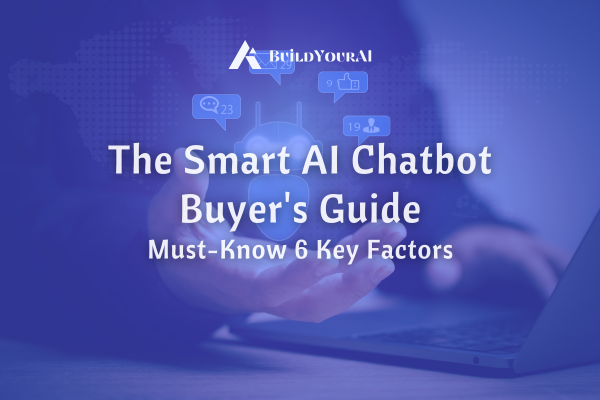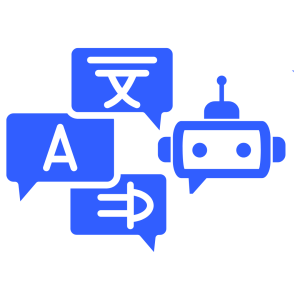Blogs

The Smart AI Chatbot Buyer's Guide: Must-Know 6 Key Factors
Blog
May 28, 2024 • 3 min read
Today, customer experience relies on digital conversations, so it’s natural that finding an AI chatbot that not only talks but understands like a human is the need of the hour for every forward-thinking business.
When on the hunt for an AI chatbot that aligns with your business ideals, it’s crucial to scratch beneath the surface. You want a bot that doesn’t just tick boxes but redefines the conversation. Something like a smart AI chatbot.
Keeping this in mind, we’re highlighting six fundamental yet often overlooked elements that distinguish a garden-variety chatbot from the crème de la crème of conversational AI.
1. The Need for Tailored Control and Customization in AI Chatbots

While out-of-the-box Large Language Models (LLMs) like ChatGPT may seem impressive at first glance, they often lack the necessary guardrails and customization options required for serious business applications.
- Remember, an AI chatbot is a direct representation of your company, and it needs to align with your brand’s unique voice, personality, and communication style.
- Without the right boundaries and bespoke tailoring, they’re prone to mishaps that could spiral quickly.
- When evaluating potential solutions, prioritize tools that offer comprehensive customization capabilities, allowing you to tailor the chatbot’s behavior, tone, response length, and other nuances to ensure consistency across all customer touchpoints.
- This level of control is essential for maintaining a cohesive brand experience and fostering strong customer relationships.
The takeaway?
‘’There is no universal answer to customer queries. The AI tool you choose must offer deep customization features to align seamlessly with your brand’s unique attributes—from tone and style to product mentions and concise answers.’’
Opt for an AI that can adapt to your distinctive edge, ensuring reliability that prevents the type of fiascos no brand wants to navigate.
2. Proficient Multilingual Support in AI Chatbots

Your homegrown brand is all set to go global and enter new markets. It’s a dream leap—taking your local success to a worldwide stage. There’s just one crucial thread: ensuring the essence of your brand speaks just as vibrantly across different languages.
Can your finely tuned brand voice maintain its integrity in multiple languages?
As AI chatbots become part of your global strategy, the question arises: “Can your finely tuned brand voice maintain its integrity in multiple languages?” True, AI chatbots are fundamentally polyglots, thanks to the underlying Large Language Models (LLMs). Yet, it’s common knowledge that these models’ proficiency often dips beyond the English Language—owing to a predominance of English data during their training.
Niche vernaculars, that industry-specific colloquial language? AI might stumble, misinterpreting words that are second nature to your brand’s identity. Take, for instance, distinctive product names or catchy slogans—less frequent in datasets, these might face translational blunders.
- Going global means nailing the local touch.
- Verify that your AI chatbot can not only converse but also convincingly carry your brand essence across linguistic boundaries.
- Ensure it allows you to safeguard brand-specific terms, maintaining their authenticity and resonance, from one corner of the globe to another.
3. Essential Web Scraping Abilities for AI Chatbots

Imagine this: an eCommerce platform bustling with activity—refunds being processed, customer complaints addressed, packages dispatched. Now picture supercharging your customer support with an AI chatbot that knows your business inside out.
If you’re running a dynamic store, especially one with an ever-expanding catalog, creating your Knowledge Base by hand is the last thing you’d want. The goal is to automate, not get bogged down with tedious data entry. Before you commit to an AI chatbot, verify it can import and digest your website content directly from URLs.
- Ponder on the feature’s adeptness at formatting.
- Does it neatly structure your content, or does it get muddled with immaterial details like meta descriptions or button texts?
- Can it seamlessly link to your product pages?
You might think, “But it’s AI, it’ll understand and give me a response,” right? Well, not quite. Precision in these details matters. It shapes the so-called ’embedding’ of your data, translating your pages into AI-friendly language.
- Consider as well how this AI organizes that knowledge.
- Your information architecture should reflect a clear logic—terms and conditions stored separately from the latest promotions, for example.
- The best tools craft a distinct database entry for each of your pages.
Lastly but importantly, the power to choose is critical. Sometimes, including every nook of your website isn’t necessary. A superior AI chatbot solution will let you select specific pages to include, giving you a tailored and manageable database.
4. Avoiding Vendor Lock-In and Maintaining Service Reliability

Your chatbot might boast its brains from popular LLMs like GPT-3.5, yet, even the best of the best hit snags with occasional downtimes.
- When deploying an AI chatbot as a key player on your digital front, having backup solutions to prevent any unexpected naps is non-negotiable.
- The flexibility to switch between LLM providers ensures your chatbot keeps ticking, and varying models may bolster uninterrupted service.
- For those vigilant about privacy or specific LLM policies, dodging vendor lock-in is a tactical choice—opt for a chatbot solution that supports this freedom.
5. Managing Intricate Conversations with Finesse

Understand the questions your customer support comes across. Most AI chatbots can juggle light and routine queries easily. Yet, sporadic complex issues or queries needing specific human interventions are bound to arise.
Rather than having a bot fumble or falter:
- Pinpoint features that empower you to step in at critical moments.
- A competent AI chatbot should perceive when a human touch is necessary—like sensing an escalated customer concern—and smoothly transfer the conversation to live support.
- Supplement this with customizable triggers, like keywords signaling a human handoff—”refund” or “cancel”, for example.
- Ensure your chatbot and human team operate in harmony, conveying available hours and setting expectations for response times.
6. Smooth Integration with Your Tech Ecosystem

A chatbot’s prowess is magnified by its ability to integrate across the platforms where your conversations happen. Check whether it’s a widget on your site, a nifty presence on WhatsApp, or a helpful bit of code in Slack—your AI companion should extend your brand’s reach without stretching your IT resources.
Seek solutions with effortless ‘plug-and-play capabilities, ensuring your chatbot is accessible where your customers are without requiring complex tech maneuvers.
As you chart your course through the diverse AI chatbot market, these six factors serve as your navigational stars—guiding you to a choice that amplifies your customer engagement, preserves the integrity of your brand, and seamlessly integrates into the flow of your business operations.
Remember, conversational AI is not just about finding a chatbot—it’s about uncovering a responsive, reliable, and reflective partner that resonates with your customers’ needs and your business’s ethos. So, whether it’s control with customization, multilingual finesse, avoiding vendor lock-in, managing complex dialogues, or ensuring effortless integrations, take the time to evaluate your options.
The right AI chatbot doesn’t just answer queries; it connects, understands, and evolves with your business. With this guide as your compass, you’re now equipped to navigate the vast sea of AI chatbots and select a solution that not only talks the talk but walks the walk alongside your brand’s journey.

Shahed Islam
